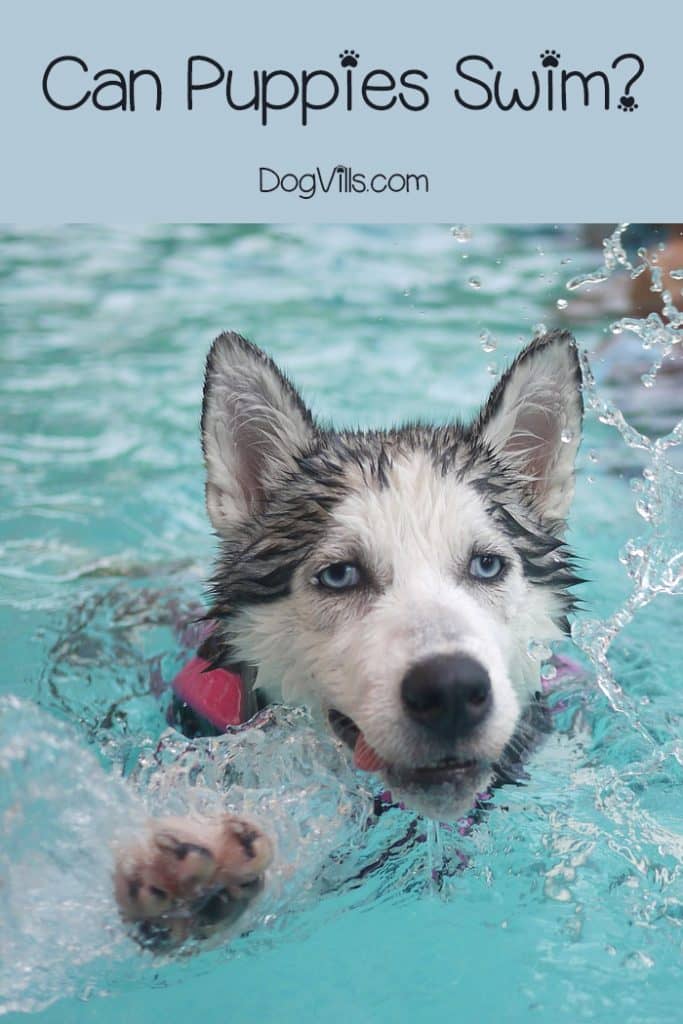Can puppies swim?
I see this question often in dog forums.
Whether an owner wants to teach their puppy to swim or just wants to know if they’ll be okay should they find themselves in water, the question is asked quite frequently.
Today, we’re going to answer the question: can puppies swim?
We’ll also talk about water safety for dogs and how to teach them to swim. It’s all about water fun and safety today.
Related: How to teach your dog to swim
Can Puppies Swim
The simplest answer to that question is “yes and no.”
Don’t worry, though. I’ll be going into far more detail that.
The answer to this question is a bit murky, as there are several factors that play into it.
Dogs, even puppies, will naturally begin “dog paddling” whenever they find themselves in water.
However, a natural tendency to paddle doesn’t mean they can swim. In fact, it doesn’t even mean that they can stay afloat for any appreciable length of time.
- Some dogs can be taught to swim with a little coaxing.
- Some dogs are natural born swimmers.
- Then there are breeds which were never meant to swim and that even with practice simply cannot physically perform the task.
Water is a real danger for this latter group as they may stay afloat for a minute or two but will invariably sink after a short period of time.
Dogs Bred for Water
Dogs that were bred for water are natural swimmers.
It generally takes little to no coaxing to get them into the water or to swim outright. They simply have the physical structure and the drive to do so.
These breeds are often medium to large breeds. They also have water-resistant coats and webbed toes.
Their webbed toes act as natural flippers, while their larger size allows them to displace more water with each stroke of their paws.
The water-resistant coat helps insulate them from getting too cold from the water in which they’re swimming.
Examples of “water dogs” include:
- Standard Poodle – Its name is derived from the word pudeln which means “to splash”.
- Newfoundland – This breed was specifically bred to be a working water dog.
- English Setter – This dog was bred to be a water retriever and is very at home in the water.
- Irish Water Spaniel – Bred as a sporting dog and water retriever.
- Labrador Retriever – This popular breed is the ancestor of a fishing and retrieving dog from Newfoundland and Labrador.
Dogs That are Able to Swim
This category encompasses all dogs that, while not bred for the water, can swim when taught and supervised.
Dogs medium to large breeds with long legs and a lighter frame tend to be able to swim for short periods.
However, because these breeds were not bred specifically for the water, and therefore lack the built-in advantages of water dogs, it is imperative to keep them close at hand.
Life jackets are recommended.
Dogs that Should Never Swim
The answer to: can puppies swim is a resounding “no” with these breeds.
Dogs that should never swim, and frankly can’t do it even if they want to, tend to have the same features.
- They’ll have large, heavy chests relative to their rears.
- They will also often have short muzzles.
There are also some breeds who may not have those traits but who are susceptible to catching a chill when in the water for too long.
These dogs should only be allowed to play in the water if they are wearing life jackets, and for those breeds which can catch a chill, water play is recommended to be in short bursts with a towel handy to dry them off and warm them up.
Examples of dogs that can’t swim include:
- English Bulldog – A prime example of a dog built for dry land. This breed has a heavy chest, small hindquarters, and a “squished” face, making water a real danger for him.
- Corgi – Featuring a dense body with a deep chest and short legs, this little guy is no swimmer.
- Basset Hound – This breed has webbed feet, but he’s no water dog. He has a huge barrel chest and the heaviest bone structure of any dog.
- Pug – Another heavy bodied, short-muzzled dog. This breed will find staying afloat for any length of time difficult.
- Boxer – Although he has long legs, he has the same issues of the English Bulldog and Pug. His barrel chest and short snout make swimming dangerous.
Teaching Your Dog to Swim
Can puppies swim? Well, most can for at least a short time.
All dogs should be taught to swim in some fashion.
Even an English Bulldog can stay afloat long enough for help to arrive if you are nearby.
Generally speaking, being able to dog paddle for at least a very short time can increase a dog’s chance of survival if he finds himself in trouble.
1. Never Leave Your Dog Unsupervised
First thing’s first. Whether you have a furry mermaid on your hands or a short-muzzled tank, never ever leave your dog unsupervised around water.
Remember, dogs are just fuzzy toddlers. They don’t really understand the dangers around them.
2. Make Water of all Kinds Fun
Play with the water hose. Splash in the kiddie pool (if he’s into it). Just get wet. The more your dog loves the water, the more he’ll want to swim.
3. Start Small
If you want to find the answer to “can puppies swim” and not the answer to “how fast can a puppy drown” NEVER use the sink or swim method.
Even if your pup survives, it is a traumatic event.
- Start small instead.
- Fill a kiddie pool with enough water to reach the first joint on your pup’s leg, then encourage him to go into the water with a toy or even with you.
- This stage is just getting him acclimated to a new sensation.
Again, even if your pup is gung-ho for the water, keep him in check. Start small, and make sure he is well-prepared for anything more than knee-deep play.
4. Gradual Steps
Puppies are like kids. They need to be led gradually into something new.
So “can puppies swim” doesn’t turn into “why is my dog afraid of water” gradually increase the depth of water when teaching your pup to swim.
- Go from first joint depth to chest or even slower.
- Be sure your pup is totally comfortable with the current level before increasing it.
- Continue this until your pup is finally dog-paddling his little heart out.
5. Safety, Safety, Safety
In addition to keeping an eye on your dog at all times, keep a life vest on them at all times, as well.
The real question is not “can puppies swim”. Rather, it should be “can puppies swim safely.”
All dogs can find themselves in danger while in the water.
A weak swimmer should have a life vest on so he won’t sink.
A strong swimmer should have a life vest on so that he doesn’t swim to exhaustion (and some dogs will) and be left in a dangerous situation.
Can Puppies Swim? They Can if You Teach Them
Can puppies swim? Well, yes, at least a little.
Almost all breeds can stay afloat for a minute, but only certain breeds can really get out there and tear it up in the water.
In my opinion, all dogs should be taught to swim as best as they can for their own safety if any water mishaps occur.
Even a dog specifically built for dry land may have an increased chance of survival if he can tread water for even a very short amount of time.
Teach your dogs to swim for their own safety, and for some water fun, but be vigilant about safety.
Never go near water, on boats, or for a swim without a life vest on yourself and your dog at all times.
If you use proper safety and teach your dog to swim at his best, you should find the answer to “can puppies swim” to be “yes, but with safety in mind”.
Did you teach your puppy to swim? Share your tips below!
Author
-

A former Veterinary Assistant at Southwest Animal Care Hospital, Ben is an animal lover, blogger, and all-around geek. Along with writing for DogVills, Ben runs his own virtual assistant company, BizzyBim.
View all posts







